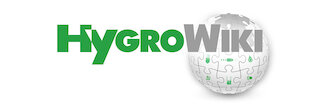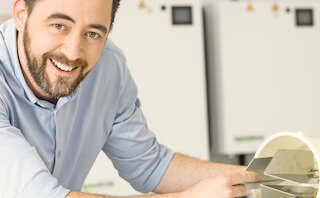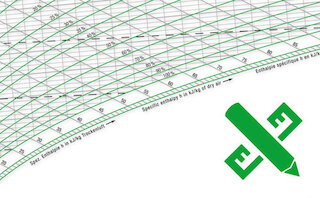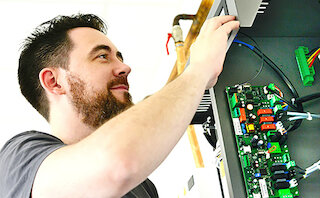Why humidify the air? How does reverse osmosis work, and how can I calculate the hardness level in other countries
Our HygroMatik world of services
Why do some spaces need humidification?
- Because humans can become ill at humidity under 40% rH. The skin and mucous membranes can dry out if they do not have adequate protection against penetrative viruses and bacteria.
- Because many materials are sensitive to changing air humidity hygroscopic materials). So for example, paper, cloth or woods need a certain, constant air humidity so they don
General terms used in air humidity
- Air is gas mixture consisting of 78.1% nitrogen, 20.9% oxygen, 0.9% argon, 0.03% carbon dioxide and 0.01% hydrogen, as well as small amounts of other gases such as helium, neon, krypton or xenon. Air consisting exclusively of the components above is dry air. Air in connection with water steam is moist air. In nature, air exists exclusively as moist air, no matter whether it
The most important thing about steam.
- Saturated steam is steam, which cannot absorb any more liquid. This steam is still in direct contact with water.
- Over-heated steam arises from saturated steam which is further heated under constant pressure. Overheated steam is no longer saturated.
- Unsaturated steam arises from overheating saturated steam, or when the volume of saturated steam is increased at a constant temperature.
- Condensation arises when steam cools. Condensation also occurs in nature when the dew point of the air is reached, i.e. the air at a given temperature cannot absorb any more water.
The most important facts about water quality and hardeners.
- In untreated condition, water should be of drinking water quality for air humidification. With spring water, for example, you should discuss this with the manufacturer of the humidification system. Depending on its origin, water can contain a range of constituents which determine water hardness and affect the operational behaviour of air humidifiers.
- Water hardness refers to the amount and nature of constituents in the water which create hardness. In Germany, water hardness is expressed in
What you need to know about water treatment.
- Water softening is generally the replacement of calcium and magnesium ions with sodium ions. This makes the water softer and less hardening agent (lime) precipitates.
- Complete water desalination removes all mineral salts from the water. We differentiate fundamentally between two systems: Ion exchangers and reverse osmosis. Ion exchange is a method of full desalination of feed water. Special resins replace all the cations contained in the untreated water for hydrogen ions (H) and all associated anions for hydroxyl ions. The hydroxyl groups and the hydrogen ions combine to form H2O (water) Depending on the output requirement, ion exchangers work with a 2-column system, where exchange resins are stored separately (each in one column). For low and medium output, we use a mixing bed, where both resins are held, mixed in a container (cartridge).
- Reverse osmosis: In reverse osmosis, all mineral salts are removed from the water after initial softening using a semi-porous membrane under pressure. Fully desalinated water is no longer conductive, and so is not suitable for electrode steam humidifiers, and contains no hardeners. So it is ideal as feed water for heater steam humidifiers, which, when operated with fully desalinated water, need practically no maintenance, as there is no build up of hardeners. However, fully desalinated water can be diluted into a less conductive feed water for electrode steam humidifiers using tap water, so that the life span of the cylinders increases significantly.
Methods of air humidification.
- Atomisation (spray nozzles and centrifugal atomisation). Here, the humidification water is atomised into very fine droplets, or aerosols. The aerosols take the energy needed for conversion into a gas from the surrounding air, in the form of heat. This means the atomisation has a cooling (adiabatic) effect on the temperature of the room. The electrical energy requirement is particularly low in this type of humidifier.
- Spray nozzle atomisation Spray nozzle systems work either with water alone, or with water and compressed air. WIth single-substance nozzles, the fully desalinated humidification water is compressed at a pressure of 50-60 bar in special high-pressure nozzles and atomised into aerosols. Two-substance nozzles work with compressed air and water, which means there is no need for an additional increase to the water pressure.
- Centrifugal atomisation Here fresh water is applied to a rotating disc, where it is pulled into a thin film by centrifugal force. At the outer edge of the disc, the water is accelerated onto special baffle teeth, which atomises it into aerosols and propels it into the room.
- Steam air humidification Here, water is heated and the air is humidified with the pure water steam generated.
- Electrode steam air humidifiers are suitable for use with conductive water (e.g. mains water). Electrodes are arranged in a special steam cylinder. When water is introduced, the electrical circuit between the electrodes is closed and the water heats up: These produces pure, odourless water vapor.
- Heater steam air humidifiers work on the immersion heater principle. Heating elements in the steam cylinder heat the water. So this type of humidification is suitable for all water qualities, whereby fully desalinated feed water keeps maintenance to a minimum.
- pressurized steam systems Here the humidifier is connected individually to the existing steam network. The arising dry steam makes very short humidification distances possible.









